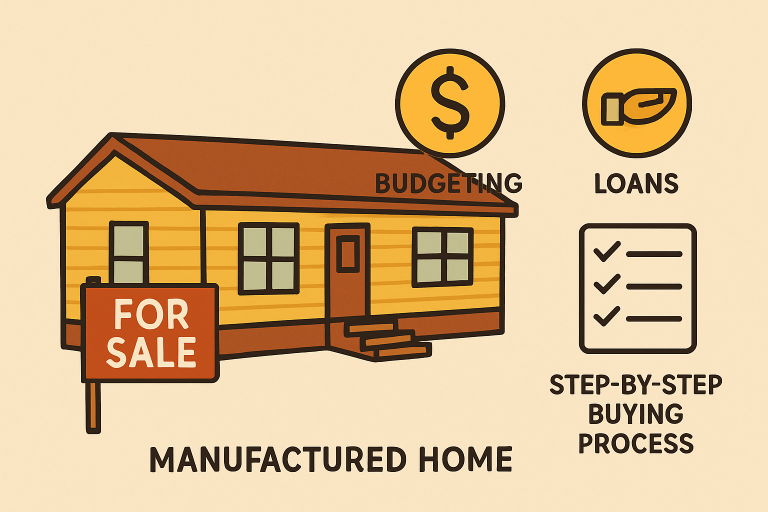Purchasing a manufactured home is a smart and accessible way for many people to attain affordable homeownership. Unlike traditional site-built homes, manufactured homes often provide more flexibility in location and customization while remaining budget-friendly. Reviewing available mobile homes can offer a great starting point for those exploring their options and help you familiarize yourself with various models and price ranges in your region.
With careful planning and the right guidance, you can efficiently navigate each step of the manufactured home buying process. Below is a step-by-step guide covering what to expect and how to prepare for a seamless transition into your new home.
Determine Your Budget
The process begins with a realistic look at your finances. Examine your income, savings, and credit to determine what you can afford. While manufactured homes are less expensive than their site-built counterparts, costs vary depending on the home size, features, and location. Don’t forget to include expenses beyond the sticker price, such as land purchase or lease, utility hookups, insurance premiums, property taxes, and ongoing maintenance.
Explore Financing Options
Financing a manufactured home can be different from securing a traditional mortgage. Here are the most common loan types for manufactured home buyers:
- FHA Loans: Backed by the Federal Housing Administration, these loans are accessible to buyers with moderate or lower credit and allow for smaller down payments.
- VA Loans: Qualified veterans and active-duty military can access VA loans, often with no down payment required and favorable terms.
- Chattel Loans: If your home will not be affixed permanently to land (such as homes in leased communities), chattel loans offer a solution, though often at higher interest rates and shorter terms.
Carefully compare offers from different lenders and research their requirements.

Choose a Location
One key benefit of manufactured housing is the flexibility of siting your home. Consider whether you’d prefer private land or the amenities of a manufactured home community. Each option has pros and cons:
- Private Land: Buying your own land gives you more autonomy and possible appreciation, but also involves costs for purchase, permits, and site development.
- Manufactured Home Communities: These communities offer amenities, social opportunities, and streamlined placement but usually require monthly lot rent and adherence to community guidelines.
Always check with local zoning offices to ensure your placement plan meets legal requirements and will suit your long-term needs.
Select the Right Home
Manufactured homes are highly customizable. Start by considering your preferred size—a single, double, or triple-wide. Reflect on your daily living needs, desired energy efficiency, and optional upgrades. Today’s homes can come with luxury finishes, open layout designs, state-of-the-art appliances, and even smart technology.
Visit Model Homes
Visit model homes and view floor plans whenever possible to get a feel for layouts and finishes. This hands-on approach helps narrow your preferences and understand what’s included in base models versus optional upgrades.
Secure Financing and Finalize Purchase
- Apply for Financing: Once you’ve chosen your home and site, complete lender applications by providing documentation like proof of income and credit details.
- Review Loan Terms: Before committing, carefully evaluate the offered interest rates, repayment terms, closing costs, and other fees.
- Sign the Contract: Review the purchase and loan agreements to clarify all clauses and ensure you understand the terms fully before signing.
Prepare the Site
Site preparation ensures your manufactured home is installed safely and legally:
- Obtain Permits: Work with your local authority to get the necessary building, zoning, and utility permits.
- Prepare the Land: Level the site, establish utility access for water, sewer, and electricity, and address drainage needs.
- Foundation Options: Choose between permanent (such as concrete footings) or temporary foundations, as dictated by local codes and financing.
Delivery and Installation
Once permits and site work are in order, coordinate delivery and installation:
- Transport: Your manufactured home is delivered, often in sections, and positioned on the prepared site.
- Professional Installation: Crews anchor the home, connect utilities, and complete required safety inspections before you take occupancy.
Final Inspections and Move-In
- Inspection: Confirm all systems—electrical, plumbing, HVAC—are working and meet manufacturer and local government standards.
- Certificates and Utilities: Secure all required occupancy permits, and verify that your utilities are connected and ready for use.
After passing inspections and setting up utilities, you’re ready to move into your new manufactured home and enjoy the peace of mind that comes with affordable, modern living.
By understanding each step of the manufactured home buying journey, you’ll be better prepared to make informed choices and start your homeownership journey with confidence.
